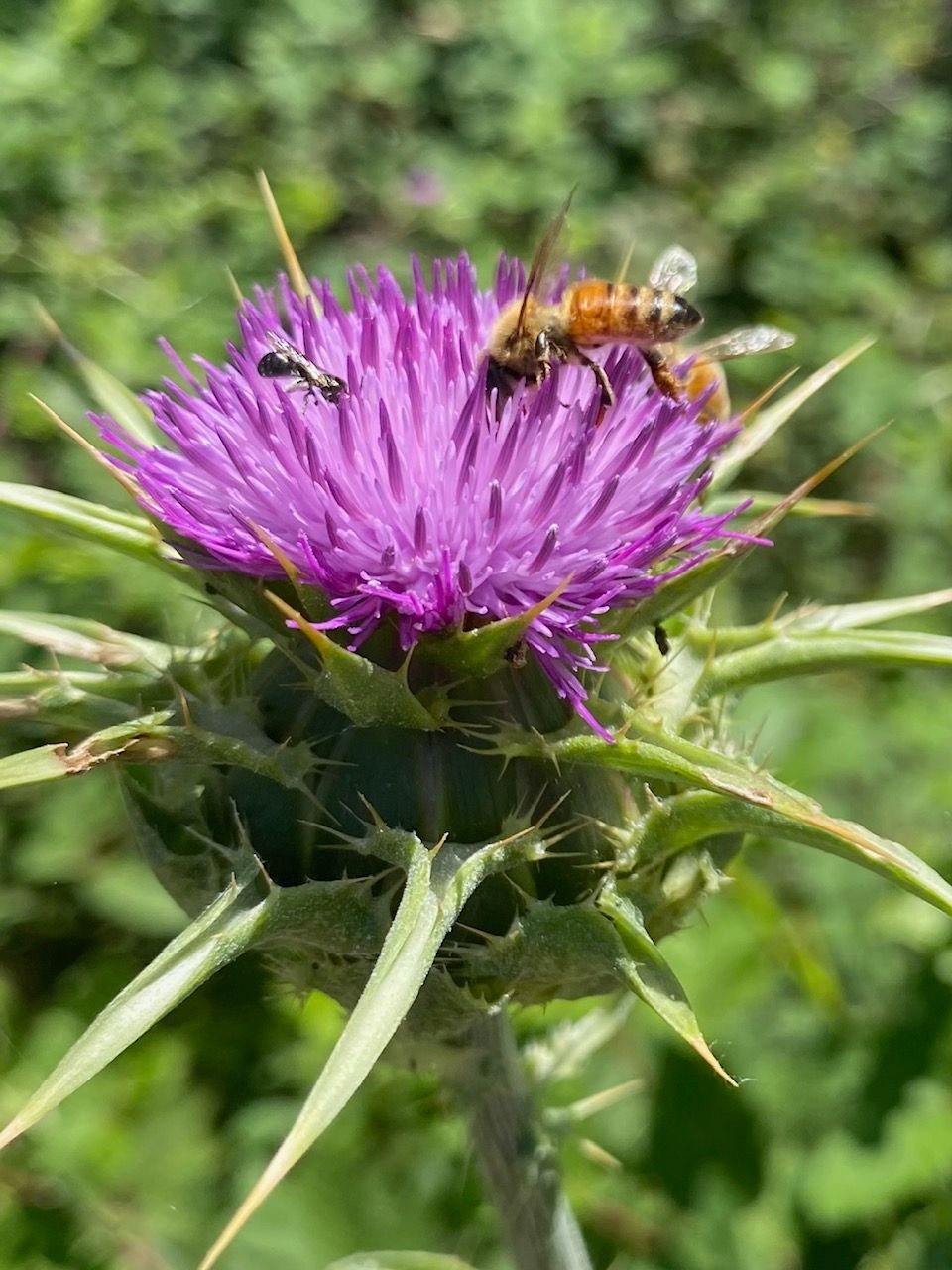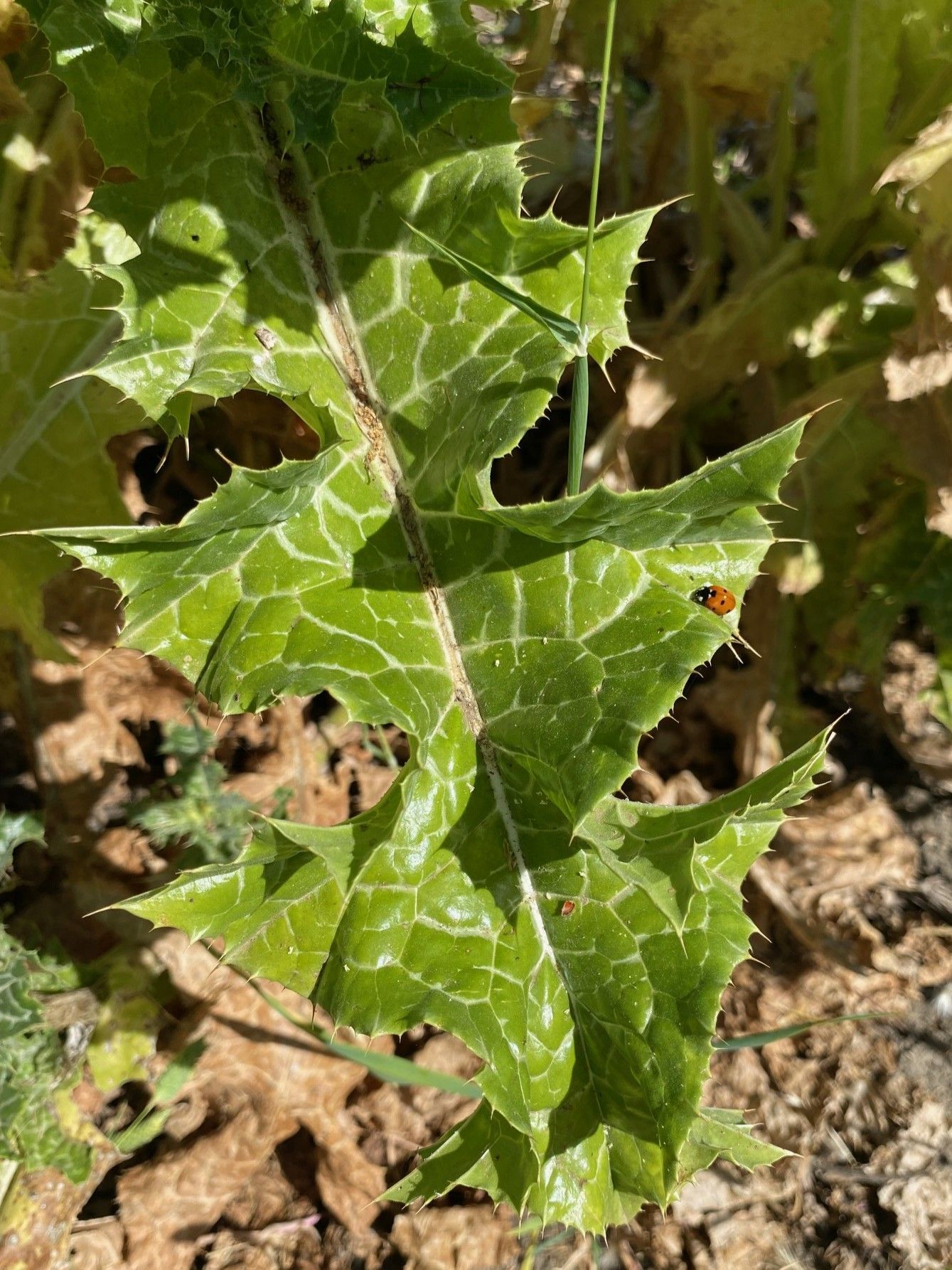Enjoying Outside - Appreciating Milk Thistle!

Surely you’ve encountered Milk Thistle (Silybum marianum). It’s a noxious weed with a knockout magenta flower. The leaves are large and shiny green with white marbling and half inch long spines. It is labeled an invasive weed because it spreads aggressively and can form dense patches outcompeting native vegetation and causing nitrate toxicity in livestock.
Native to the Mediterranean, much of Europe, Asia and India, it came to North America via the early colonists. Originally it had been propagated for medicinal uses however it has escaped cultivation and can now be found in nearly any disturbed place with ample sun. Although plants can flower their first year, most commonly they are biennials (having a two year life cycle). Seeds germinate in the fall and begin life by putting out two cotyledons and later a bigger basal rosette, both with white marbling. During the spring and summer the plant develops a hardy taproot that helps it outcompete neighbors for moisture when things begin to get hot and dry. The tap root along with dense foliage and the ability to withstand cold temperatures make Milk Thistle very difficult to exterminate once it gains a foothold.
Milk Thistle belongs to the sunflower (Asteraceae) family and plants can reach six feet tall and have large, pinnately lobed leaves with the aforementioned white marbling - an identifying characteristic of Milk Thistle. The plants flower from early spring to late fall and both the leaves and the base of the flowers are armed with long, nasty spines. It can thrive in a variety of soil conditions and reproduces by wind-dispersed seeds; both which have aided it in spreading indiscriminately. Milk Thistle can be found throughout California in overgrazed rangeland, along roadsides, fence lines and virtually any other ruderal or maintained area.
So, now that you’ve heard how invasive it is, how about recognizing some of the benefits of this beautiful thistle.
The medicinal values of Milk Thistle are somewhat undetermined although it is believed that the flavonolignan complex called silymarin, which is found in the seeds, is believed to have antimicrobial as well as anticancer properties. It is also presumed to have the ability to help protect the liver, heart and blood vessels, nervous system and even skin from damage or injury. Research is also being conducted on its potential to help lower blood sugar along with other benefits such as counteracting the toxicity of pesticides, antibiotics and metals. A recent study is also showing that silymarin may be effective in the treatment of Death Cap (Amanita phalloides) and other toxic fungi poisoning.
In addition to its therapeutic properties, Milk Thistle is also edible. The leaves and stems can be collected and boiled with salt after removing the spines. The roots can be eaten roasted or raw and the flower head can be cooked and eaten like a small artichoke.
Not only is Milk Thistle edible for humans but it also provides a very important source of nectar for a variety of beneficial pollinators as well as adding brilliance and pizazz to your garden. A variety of species of bees, butterflies and even birds flock to the stunning magenta flowers to collect the nectar. While collecting nectar, these friends also play an essential role in the pollination process. And, not only do birds play a key role in pollination, they can also help control some pest species that you may not want in your garden. Milk Thistle not only attracts a medley of pollinators but the biodiversity of your garden will also be increased and enhanced.
Next time you’re strolling around your neighborhood and come across a marbled thistle with a dazzling purple plume, take a minute to look at it a little closer. Chances are good that you’ll find some happy bees or butterflies doing their thing!
-Kristie Ehrhardt (kehrhardt@tuleyome.org)
Tuleyome Land Conservation Program Manager

RECENT ARTICLES






